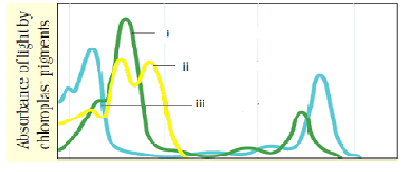Column I
Column II
i. grana
a. dark reaction
ii. Stroma
b. light reaction
c. synthesis of ATP and NADPH+H+
d. synthesis of sugar
1. i-b, c; ii-a, d.
2. i-a, d; ii-b, c.
3. i-b, d; ii-a,c.
4. i-b; ii-a, c, d.
2. i-a, d; ii-b, c.
3. i-b, d; ii-a,c.
4. i-b; ii-a, c, d.
How many of the following statements are correct?
i. Products of dark reaction are substrates of light reaction.
ii. Products of light reaction are substrates of dark reaction.
iii. In the stroma, enzymatic reactions incorporate CO2 into the plant leading to the synthesis of sugar.
iv. Dark reactions are directly light-driven.
v. Chloroplast is a single membranous organelle.
1. 2
2. 3
3. 4
4. 1
Products of light reaction does not include-
a. ATP & NADPH
b. CO2
c. O2
d. Electrons
Absorption spectrum of chlorophyll- ‘a’ is shown by-
a. i
b. ii
c. iii
d. Not shown.
How many pigments are responsible for the color of a plant leaf?
a. 1
b. 2
c. 3
d. 4
After performing the chromatographic separation of a plant leaf, experimentor found bright or blue green colour in the chromatogram. Then this pigment should be-
a. xanthophyll
b. carotenoid
c. chlorophyll a
d. chlorophyll b.
Range of wavelength at which chlorophyll-a shows the maximum absorption:
a. 400-450 nm
b. 450-500 nm
c. 650-700 nm
d. 500-600 nm.
Which of the following is the chief pigment associated with photosynthesis?
a. chl-a
b. chl-b
c. chl- a and xanthophylls
d. chl-a and carotenoids
How statements are correct?
i. chlorophyll-a , xanthophylls and carotenoids are called as accessory pigments.
ii. accessory pigments protect chlorophyll-a from photo-oxidation.
iii. chlorophylla are the major pigments responsible for trapping of light
iv. chl-a and chl-b forms the reaction centre
v. chl-a transfers the energy to accessory pigments.
a. 2
b. 3
c. 4
d. 5
Photochemical phase does not include-
a. water splitting
b. oxygen release
c. CO2 assimilation
d. light absorption






